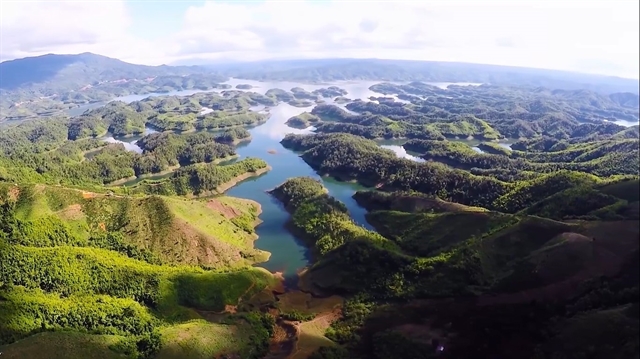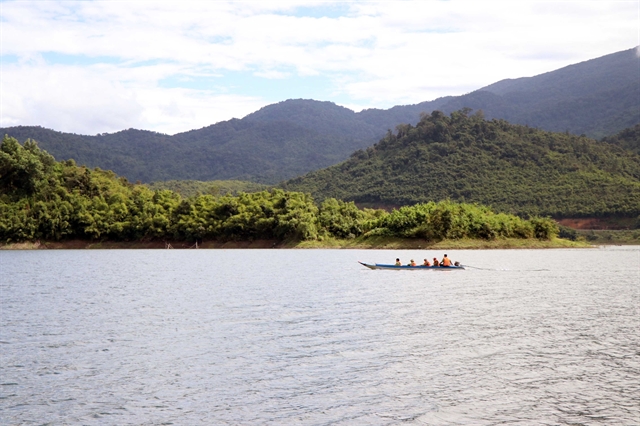 Environment
Environment

 |
| A view of Tà Đùng Lake in Tà Đùng National Park in the central highland province of Đắk Nông. VNA/VNS Photos Hưng Thịnh |
ĐẮK NÔNG — Supporting communities in the buffer zones of Tà Đùng National Park in the Central Highland province of Đắk Nông to improve their livelihoods is among the most effective strategies for forest protection and sustainable development.
According to the park’s management board, this approach has reduced pressure on forest resources, raised community awareness and encouraged local residents to actively participate in conservation.
Under the Prime Minister’s Decision No 809/QĐ-TTg on the Sustainable Forestry Development Programme for 2021-2025, Tà Đùng National Park Management Board completed support initiatives for buffer zone communities in early July.
These initiatives benefit 31 hamlets across Đắk R'Măng and Đắk Som communes in Đắk Nông Province, as well as Phi Liêng, Đạ K'Nàng, Phúc Thọ, Tân Thanh and Định Trang Thượng communes in Lâm Đồng Province.
The management board collaborated with stakeholders to install 28 solar-powered streetlight systems and build three public facilities, with a total budget of nearly VNĐ1.25 billion (US$49,220).
Funding came from the State budget as part of the 2024 Sustainable Forestry Development Programme, approved by the Đắk Nông People’s Committee on December 13, 2023, with an allocation of VNĐ40 million ($1,570) per hamlet per year.
For years, the Tà Đùng National Park Management Board has carried out support projects for the communities in the buffer zones. In 2023, it supported 26 community projects in these areas, including entrance gates, solar street lighting systems and rural road construction with a total budget of VNĐ1.04 billion ($40,950).
The park’s buffer zone spans approximately 25,000ha across seven communes in Đắk Nông and Lâm Đồng provinces. This area includes natural forest lands with complex terrain, adjacent to long-standing agricultural lands.
Supporting these communities enhances the livelihoods of those living near the forest, helping to alleviate pressure on resources, boost public awareness and encourage people to participate in conservation, protection and biodiversity preservation.
 |
| Forest rangers conduct a patrol on Tà Đùng Lake in Tà Đùng National Park in the central highland province of Đắk Nông. |
The management board also regularly holds awareness programmes, integrating educational messages into community meetings to help locals understand the adverse impacts of deforestation and illegal resource extraction, as well as the benefits of forest conservation.
For the 2021-2025 period, the management board’s initiatives focus on building production capacity for those in buffer zones through agricultural extension programmes, providing crop and livestock supplies, small-scale agricultural processing equipment and construction materials for community infrastructure.
K’Ting, head of the B’SrêA hamlet in Đắk Som Commune, Đắk Glong District, said that in addition to providing support for buffer zone residents, the Tà Đùng National Park Management Board has also been involved in educational activities to raise awareness about forest conservation among the community.
This initiative has not only brought joy and fostered a close connection between park officials and villagers but has also improved understanding among locals about forest conservation, including simple, practical actions they should or should not take.
People in the village encourage their families and remind themselves to protect the forest, viewing it as essential to preserving their own living environment and that of the community, he said.
Residents in the hamlets have signed agreements to uphold forest protection regulations, complying with the Law on Fire Prevention and Fighting, the Criminal Code, the Law on Biodiversity, the Forestry Law and various Government decrees related to forest management, wildlife protection and the effective use of state funds allocated for community projects.
Khương Thanh Long, Director of the management board, noted that the board is focusing on enhancing educational outreach and raising awareness among residents of buffer zones.
He said the more effectively the board engages in community outreach, the more support and unity it receives from the people, leading to better outcomes in forest management and conservation. The management board recognises community involvement and support from buffer zone residents as essential for successfully achieving its conservation goals. VNS




